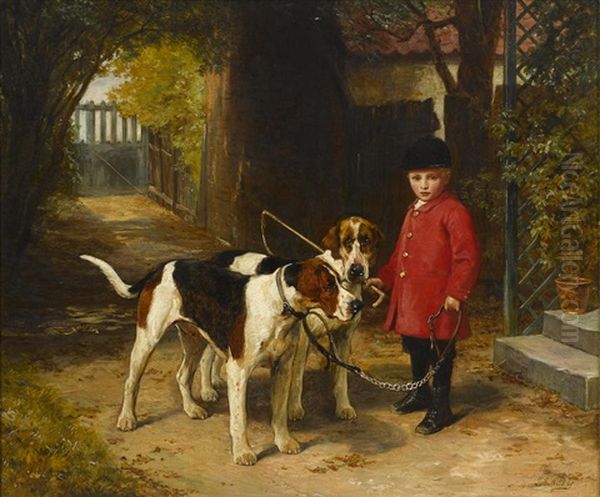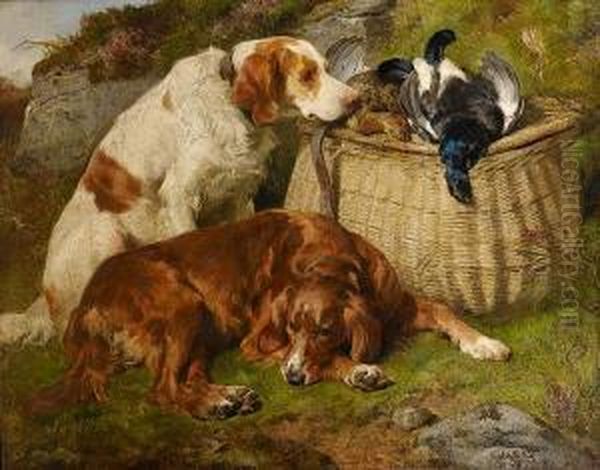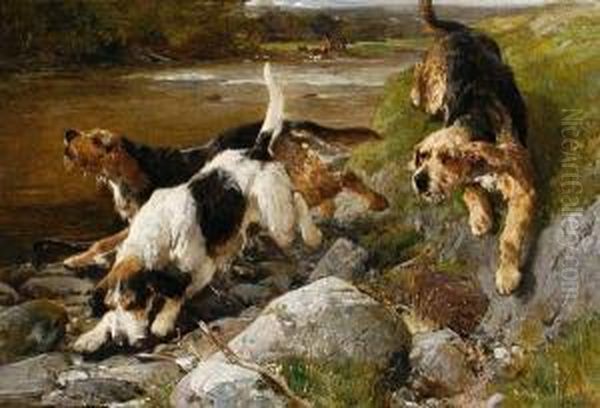John Sargent Noble (1848–1896) was a British artist who carved a distinct niche for himself within the vibrant and diverse art scene of the Victorian era. While perhaps not possessing the same level of widespread, enduring fame as some of his contemporaries like Sir Edwin Landseer or Briton Rivière, Noble was a highly skilled and respected painter, particularly admired for his depictions of animals, sporting scenes, and the rustic charm of British country life. His works, characterized by careful observation, technical proficiency, and often a gentle narrative quality, found favour with the public and fellow artists alike, earning him a consistent presence in major exhibitions of the time.
Understanding Noble's contribution requires situating him within the broader context of 19th-century British art, a period marked by a burgeoning middle-class art market, a deep affection for domestic animals, a romanticization of rural existence, and a fascination with the natural world. His paintings offer a window into these Victorian sensibilities, capturing not just the likeness of animals but also the perceived virtues of loyalty, companionship, and the enduring connection between humans and the animal kingdom.
Early Life and Artistic Formation
Born in London in 1848, John Sargent Noble emerged during a period of significant artistic activity and innovation in Britain. While detailed specifics of his earliest years and initial artistic inclinations remain somewhat less documented than those of more prominent figures, it is clear that he received a solid grounding in the academic traditions of painting. Like many aspiring artists of his generation, he would have been exposed to the influential works displayed at the Royal Academy of Arts and other leading institutions, shaping his understanding of composition, colour, and draughtsmanship.

His formal training is understood to have included time spent at the prestigious Royal Academy Schools, the primary institution for artistic education in Britain. Here, students underwent rigorous instruction, focusing on drawing from casts of classical sculptures and, eventually, from life models. This academic foundation was crucial for developing the anatomical accuracy and technical skill that would become hallmarks of Noble's animal paintings. It is also highly probable that he sought tutelage or was significantly influenced by established animal painters of the day, a common practice for artists specializing in a particular genre.
The Influence of Landseer and the Rise of Animal Painting
It is impossible to discuss Victorian animal painting without acknowledging the colossal influence of Sir Edwin Landseer (1802-1873). Landseer's extraordinary ability to imbue his animal subjects with human-like emotions and narratives captivated the Victorian public, elevating animal painting to a new level of popularity and critical acclaim. His works, ranging from majestic stags in Highland landscapes to beloved domestic pets, set a standard that many artists, including Noble, aspired to or reacted against.
John Sargent Noble, working in the decades following Landseer's peak, undoubtedly absorbed lessons from the master's approach. The careful attention to anatomical detail, the rendering of fur and feather, and the ability to capture a sense of character in his animal subjects show a lineage that can be traced back to Landseer's impact. However, Noble developed his own distinct voice, often favouring less overtly sentimental or anthropomorphic portrayals, focusing instead on the natural behaviours and interactions of animals within their environments. Other notable animal painters of the era, such as Richard Ansdell (1815-1885), known for his sporting scenes and depictions of Spanish subjects, and Briton Rivière (1840-1920), who often painted historical and biblical scenes featuring animals, also contributed to the rich tapestry of this genre, creating a competitive yet inspiring environment for artists like Noble.
Themes and Subjects: A Celebration of Rural Life
John Sargent Noble's oeuvre primarily revolved around themes drawn from British rural life, with a particular emphasis on animals. Dogs, in all their varied breeds and roles, were frequent and favoured subjects. From loyal terriers and alert sheepdogs to hounds participating in the hunt, Noble captured their distinct personalities and physical characteristics with an empathetic eye. His paintings often depicted dogs in companionship with humans, highlighting the close bond that was, and remains, a significant aspect of British culture.

Sporting scenes also formed an important part of his output. Fox hunting, otter hunting, and shooting parties were popular pursuits among the landed gentry and aspiring middle classes, and these activities provided rich material for artists. Noble's depictions of these events were not merely records of the chase but often focused on moments of anticipation, camaraderie, or the quiet dignity of the animals involved. Works featuring horses, game birds, and other creatures of the field and stream demonstrate his versatility and deep understanding of animal anatomy and behaviour.
Beyond the thrill of the hunt, Noble also painted more tranquil scenes of pastoral life. Sheep grazing in meadows, cattle resting by a stream, or farmyard animals going about their daily routines reflect a romantic appreciation for the countryside that was prevalent in Victorian society, offering an idealized counterpoint to the rapid industrialization transforming urban centres. These works often evoke a sense of peace and timeless tradition.
Artistic Style and Technique
Noble's style can be broadly categorized as Victorian realism, characterized by a commitment to accurate representation and meticulous detail. He possessed a strong command of draughtsmanship, ensuring that the anatomical structures of his animal subjects were convincingly rendered. This was complemented by a skilled use of oil paint, allowing him to capture the varied textures of fur, feathers, and foliage with considerable finesse.
His compositions were generally well-balanced and thoughtfully constructed, often employing a narrative element, however subtle. Unlike some of his contemporaries who might lean towards grander, more dramatic compositions, Noble's works often possess an intimacy and a focus on the specific character of his subjects. His palette tended towards naturalistic tones, reflecting the earthy colours of the British landscape and the true hues of the animals he depicted. While not an overtly experimental artist in terms of technique, his consistent quality and ability to convey the essence of his subjects earned him respect. Artists like Thomas Sidney Cooper (1803-1902), renowned for his cattle and sheep paintings, shared a similar dedication to realistic depiction of farm animals, though Cooper's focus was perhaps more singularly on pastoral idylls.
Exhibitions and Recognition: A Consistent Presence
A key measure of an artist's success in the Victorian era was their acceptance and regular exhibition at major London art societies. John Sargent Noble achieved this consistently throughout his career. He was a frequent exhibitor at the Royal Academy of Arts, the most prestigious venue for contemporary art in Britain. Having a work accepted for the Royal Academy's annual Summer Exhibition was a significant achievement, bringing an artist's work to the attention of critics, collectors, and the wider public.

Noble also exhibited at other important institutions, including the Royal Society of British Artists (RBA) on Suffolk Street and the British Institution. His works were noted in contemporary art journals and reviews, generally receiving positive, if not always effusive, commentary. The consistent demand for his paintings of dogs, sporting scenes, and rural life indicates a steady market for his work among private collectors. While he may not have received the same level of official honours or widespread adulation as a figure like Landseer or Frederic Leighton (1830-1896), a leading figure of High Victorian art, Noble's career was one of sustained professional achievement and recognition within his chosen field.
Representative Works: Capturing Moments in Time
While a comprehensive catalogue raisonné of John Sargent Noble's work is a task for dedicated scholarship, several paintings can be highlighted to illustrate his characteristic themes and style. One such work, mentioned in art historical literature, is "The Young Master." Though specific details of this painting might vary depending on the particular version (as artists sometimes revisited themes), the title itself evokes a common Victorian trope: a child, often from an affluent background, depicted with their loyal canine companion(s). Such paintings appealed to Victorian sentiments about childhood innocence, class identity, and the cherished role of pets within the family. They often showcased the artist's skill in rendering both human and animal figures, as well as creating a charming narrative.
Other titles that are typical of Noble's output and appear in auction records and art databases might include works like "A Critical Moment," "Highland Hospitality," "The Day's Bag," or "Waiting for Master." These titles suggest scenes of hunting, interactions between humans and animals in domestic or rural settings, and the depiction of specific breeds of dogs known for their working abilities or companionship. For instance, a painting titled "Otter Hounds" would focus on the specific breed and their role in the now-controversial sport of otter hunting, requiring the artist to capture the dogs' energy, alertness, and distinctive physical traits. Similarly, depictions of terriers, such as those by artists like George Earl (1824-1908) who also specialized in dog portraits, were immensely popular, and Noble contributed to this subgenre with his own skilled portrayals.
His Scottish scenes, often featuring deer or Highland cattle, would have tapped into the romantic fascination with Scotland that was fueled by the writings of Sir Walter Scott and the frequent visits of Queen Victoria to Balmoral. These paintings allowed for the depiction of majestic animals in dramatic landscapes, a theme also explored by artists like Louis Bosworth Hurt (1856-1929) with his popular Highland cattle scenes.
The Broader Context of Victorian Animal and Sporting Art
John Sargent Noble worked within a flourishing tradition of animal and sporting art in Britain. This genre had deep roots, stretching back to artists like George Stubbs (1724-1806) in the 18th century, whose scientific approach to equine anatomy laid a foundation for future generations. By the 19th century, the genre had diversified enormously. The aforementioned Sir Edwin Landseer was a dominant force, but many other talented artists contributed to its popularity.
Richard Ansdell, for example, often collaborated with landscape painters like Thomas Creswick (1811-1869) and was known for his large-scale canvases depicting shooting parties and scenes from Spanish rural life. John Frederick Herring Sr. (1795-1865) and his son John Frederick Herring Jr. (1820-1907) were celebrated for their equestrian portraits, particularly of racehorses and farm scenes, continuing a strong tradition of horse painting. Abraham Cooper (1787-1868) was another notable painter of horses and battle scenes.
The rise of a wealthy middle class with leisure time and an interest in country pursuits created a strong market for such art. Paintings of beloved pets, successful hunts, or prized livestock adorned the walls of many Victorian homes. Illustrated magazines and prints further disseminated these images, making animal and sporting art accessible to an even wider audience. Noble's contribution was to provide well-crafted, engaging works that resonated with these prevailing tastes, often with a slightly less grandiose or sentimental approach than some of his peers, focusing on a more direct, observational style. Even artists primarily known for other genres, like Rosa Bonheur (1822-1899) from France, whose powerful animal paintings like "The Horse Fair" gained international acclaim, demonstrated the widespread appeal and artistic merit of animal subjects during this period.
Later Career and Legacy
John Sargent Noble continued to paint and exhibit throughout the latter decades of the 19th century, maintaining a consistent output and a respected position within the British art world. He remained true to his chosen subjects, refining his skills and adapting subtly to evolving tastes without radically altering his fundamental style. The art world towards the end of the 19th century was, however, beginning to see the stirrings of modernism, with movements like Impressionism (though slower to take hold in Britain, championed by artists like Walter Sickert (1860-1942)) and Post-Impressionism starting to challenge academic traditions.
Despite these shifts, the demand for traditional genre painting, including animal and sporting art, persisted. Noble's work continued to find an appreciative audience among those who valued skilled representation and familiar, heartwarming themes. He passed away in 1896, at the relatively young age of 48, at a time when the artistic landscape was on the cusp of significant change.
In the decades following his death, as artistic tastes shifted more dramatically towards modernism, the reputation of many Victorian academic painters, including specialists in animal art, experienced a period of decline. Their work was often dismissed as overly sentimental, anecdotal, or simply old-fashioned. However, the late 20th and early 21st centuries have seen a renewed scholarly and public interest in Victorian art, with a greater appreciation for its diversity, technical skill, and cultural significance.
Today, John Sargent Noble is recognized as a competent and appealing painter of animals and rural scenes. His works appear in auctions and are held in private collections, and occasionally in public galleries. While he may not be a household name, his paintings serve as valuable documents of Victorian taste and the enduring British affection for animals and the countryside. He represents a significant strand within the rich fabric of 19th-century British art, an artist who, through careful observation and skilled execution, captured a world that was both familiar and cherished by his contemporaries. His legacy lies in these charming and proficient depictions, which continue to offer pleasure and insight to viewers today. Artists like Maud Earl (1864-1943), who followed in the tradition of detailed canine portraiture into the early 20th century, built upon the foundations laid by painters like Noble.
Conclusion: An Enduring Appeal
John Sargent Noble's career spanned a dynamic period in British art. He successfully navigated the competitive London art world, establishing himself as a respected specialist in animal and sporting painting. His works, characterized by their realism, attention to detail, and empathetic portrayal of animal subjects, resonated deeply with Victorian sensibilities. From lively depictions of the hunt to quieter moments of companionship between humans and animals, Noble's paintings celebrated the rural traditions and the natural world that held a special place in the 19th-century British imagination.
While the grand narratives of art history often focus on revolutionary figures and groundbreaking movements, the contributions of skilled and dedicated artists like John Sargent Noble are essential for a complete understanding of any artistic era. He provided his patrons and the public with art that was both aesthetically pleasing and emotionally engaging, reflecting their values and interests. His paintings of dogs, horses, and scenes of country life remain a testament to his skill and offer a charming glimpse into the world of Victorian Britain, ensuring his modest but secure place in the annals of British art. His work stands alongside that of other dedicated animaliers such as Heywood Hardy (1842-1933), who also captured the spirit of sporting and rural life with considerable charm and technical ability.